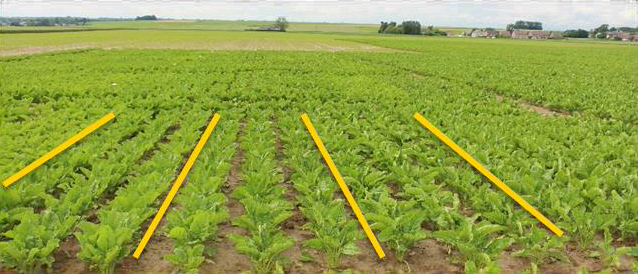Context and objectives
Sugar beet phenotyping with high accuracy and reliability for identification of resistant sugar beet varieties to biotic stresses is required but lacking. The small dimensions of breeding trial plots and the need for frequent revisits hamper the use of satellite or airborne images. UAV’s on the other hand, enable assessments at a very high spatial resolution with a very flexible temporal resolution. High-resolution hyperspectral remote sensing imagery is known to capture essential information related to the crops health status. To help to calibrate/validate UAV based phenotyping methods, ground truth data were acquired by visual observation as well as using an handheld spectrometer and an imaging ground-based hyperspectral camera. This project aims at applying the UAVs potential for the quantitative assessment of a specific plant trait (disease resistance against Powdery Mildew ‘PM’) within breeding trial plots.
Project outcome
Scientific results
Multispectral UAV data is well suited to describe plant health in general, but not able to detect individual diseases.
In field conditions, working at plot level, whatever the hyperspectral VIS-NIR device (400 – 1000 nm), the platform (ground based or UAV) and the data treatment methodology, the algorithms allow to differentiate between a maximum of 2 PM infection levels. Spectral index methods are more robust compared to machine learning approaches using all wavelengths of the spectra, like PLS-DA. The latter however would potentially allow to achieve higher accuracies at specific sites if sufficient amounts of training data would be available. Early detection of PM in the field (which is most likely the most interesting use case to farmers/breeders) turned out to be particularly challenging. PM detection methods can be transferred from ASD level to UAV level or trained directly on UAV data, but in any case require quite a lot of training data. Often, local re-calibration is still needed when applying the model on new sites. The relevant wavelengths explaining high PM score are in relation to the blue light (peak absorbance of chlorophyll), the green light (peak reflectance of healthy plant), the red edge (indicator for disease infestation) and the water content (around 950 nm). Models developed from the full wavelength range (400-2500 nm) of the handheld ASD Fieldspec4 device used in proximal sensing, did not allow to distinguish more than 2 groups of PM infection. This finding leads us to believe that, additionally capturing the 1000-2500 nm range using UAV imagery would not allow for a significant improvement in our PM detection capabilities in an operational context.
In greenhouse conditions, working at plant level, the same handheld ASD Fieldspec4 device used in contact sensing allows to define up to 3 groups of PM infection level. Additional wavelengths of interest were identified in relation to the CH and OH bands around 1200, 1400 and 1900 nm. The NIR hyperspectral imaging camera (950 – 1700 nm) was also tested. It allows to mutually distinguish up to 4 levels of PM infection. Compared to the previous section, this would mean that in a controlled environment, PM can be detected more accurately and in more detail as compared to field conditions and the addition of the NIR and SWIR spectral range in such conditions does have a significant positive impact on detection capabilities.
Alternative method using fluorescence measurement on the leaves, showed that the signal in blue green when excited in UV was also a relevant stress indicator for PM. Whatever the year and the trial in field and greenhouse, at least two groups of PM infection level could be defined according to the PM score. Further tests are still required to assess the potential of fluorescence cameras mounted on UAV platforms for PM detection in field conditions.
Societal (including environmental) relevance
The control of leaf diseases of sugar beet has gained importance in the last decade. Nowadays, due to the European IPM directive (Integrated Pest Management), it becomes necessary to combine fungicide treatments with varieties showing moderate to high level of resistance to this fungus. The project contributes to improve the PM resistance of the varieties proposed to the farmer.
Products and services
The MAPEO online platform proposes an end-to-end solution to process, visualise and analyse drone data for various applications, including phenotyping. A dedicated, machine learning based algorithm is added to the processing chain for the powdery mildew detection. The objective, clear, detailed MAPEO visualisation provides more information than can be seen with the eye, ensuring better-founded decisions. It allows SV to accurately and efficiently monitor the mildew resistance of different sugar beet varieties, optimizing effort and cost, and speeding up its cultivation and selection programmes.
Potential users
Besides SV, the potential users are breeding companies and institutions, companies involved in fungicide treatment screening (at field level) or in disease/fungicide application forecast, agricultural research centres, crop phenotyping companies, agricultural UAV companies, agricultural remote sensing sector, agricultural sensor and robotics companies.
Outreach
BEETPHEN: Mildew detection in sugar beets takes to the sky
BEETPHEN: De opsporing van meeldauw in suikerbieten neemt een hoge vlucht
BEETPHEN: La détection de l'oïdium de la betterave sucrière prend de la hauteur
| Project leader(s): | SESVanderHave | |
| Belgian partner(s) | ||
| Location: | ||
| Related presentations: | ||
| Website: | https://www.cra.wallonie.be/en/beetphen | |

